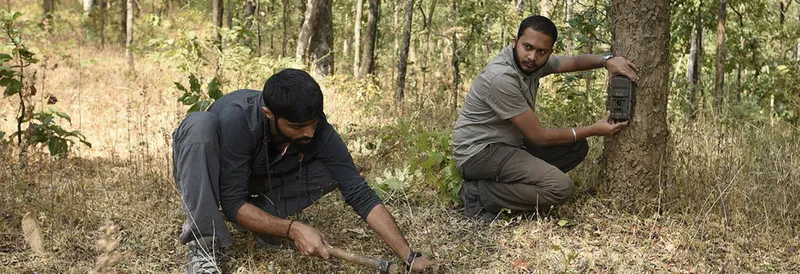How WCT is developing a 360° approach to wildlife conservation
Mumbai’s Wildlife Conservation Trust (WCT) uses science and data-based conservation to help humans and wildlife coexist and create sustainable energy solutions in Maharashtra.
Punam Jagdish Sahare was just 22 years old when she first ventured into the forest to collect firewood. Sahare, who was born in Gadchiroli—close to 80 kms from Chandrapur in Maharashtra—had grown up watching her mother get firewood from farms.
This was a new experience for Sahare, a mother of two children who was uninitiated to this practice. It was also around the same time her village in the Nagbhid taluka of Chandrapur district had lost a life to a carnivore attack.
“We went in as a group of women and stuck together,” she says. Now, however, the incident is just a faint memory.
Over the last five years, the number of women venturing into the forests of Chandrapur to collect fuelwood has dropped to a negligible number. The reason behind this decline is a metre-long metal apparatus called the bumbb—introduced by Mumbai-based not-for-profit and research organisation Wildlife Conservation Trust (WCT).
The bumbb, which was modified and introduced to the community in 2019, is at its core, a water heater. It is a cylindrical vessel with a burner below that can be fueled by crop residue, cow dung, used paper, and if needed, a little bit of firewood. The heated water is then poured through a pipe into a bucket or a vessel for use.
Today, around 12,000 households in the region have adopted this invention to heat water, greatly reducing the need to collect fuelwood from the forest and the possibility of a tiger or leopard attack, besides the hazards of inhaling smoke. The bumbb, with its simple mechanics, has also brought about division of labour, with both men and women sharing the responsibility of heating water for the household, which previously rested on women.
“Most women here had coarse, itchy throats—a direct result of burning chulha (firewood stove). This symptom has practically disappeared,” Sahare says, adding, “We also get close to 30 days a year to now go for farm labour, which we previously spent collecting fuelwood. This has brought us extra income.”
In 2002, Hemendra Kothari, a veteran investment banker and conservationist, founded WCT with the vision of wildlife conservation and ecosystem restoration through science.
Today, under the presidentship of LEAD fellow and Carl Zeiss Conservation awardee Anish Andheria, the organisation has pioneered scientific, data-based work in large-scale tiger population estimation in wildlife corridors and habitats outside protected areas.
Every year for the first ten years, Kothari contributed Rs 15 crore from his philanthropic funds to the organisation. Post Andheria’s joining, WCT has also garnered funds from the United States Agency for International Development (USAID), CSR partnerships, and other donors.
The economics of the bumbb
The dry and deciduous Bramhapuri Forest Division in Maharashtra is home to 50+ adult tigers and more than 600 villages.
The growing human habitation in the region has meant an increase in firewood consumption, which has led to forest degradation, and the most manifest of challenges—human-animal conflict.
In 2018, WCT's team of economists, psychologists, sociologists, and wildlife biologists conducted a baseline study with 2,098 households around the Ghodazari Wildlife Sanctuary in the belt, where they found that a large chunk of firewood collected - mainly by women - was used for water heating.
In fact, WCT, which works in partnership with the state forest department, knew addressing forest degradation was pivotal to their work. It was an exhaustive problem requiring an exhaustive solution.
“We are talking about an area that loses close to 40 people every year to carnivore attacks. We couldn’t simply ask these families to save the forests that harbour these animals. How would they understand the issue in the larger context?” Aniket Bhatkhande, Head of Conservation Behaviour at WCT, tells SocialStory.
He adds, “We knew we would have to understand the social, psychological, and economic factors behind
fuelwood extraction.”
According to WCT, the bumbb consumes one-third of the wood a traditional firewood stove needs to heat the same quantity of water.

The bumbb is a cylindrical metal vessel with a burner below that can be fueled by crop recipe, cow dung, used paper, and if needed, a little bit of firewood.
Bhatkhande says over 30% of the households adopted the bumbb - provided to them at Rs 1,850—25% of the original cost of Rs 7,400 - in the first year of its implementation. “ This gave them a sense of ownership,” says Bhatkhande.
“The water heater has reduced firewood usage by 70%, and what’s noteworthy is that we haven’t lost a single human being to a carnivore attack since it was introduced,” he adds.
Using data for change
The bumbb is one of many scientific interventions WCT has created to holistically approach the conservation of forest ecosystems in India.
Over the last decade, WCT has partnered with the Maharashtra and Madhya Pradesh state forest departments to create a system of forest monitoring using camera traps. Many such cameras are also placed outside protected areas to capture events foundational to critical studies and discoveries.
Through this, the organisation has observed potentially harmful human activities inside corridors and other forest patches, including the movement of armed people in broad daylight.
Recordings have also revealed dense tiger populations in areas of regular human and livestock movement. Interestingly, the images also revealed fewer conflicts in areas with high human cohabitation with sizeable leopard populations.
But perhaps WCT’s most groundbreaking discovery has been the spotting of Eurasian otters in central India, which was previously unknown.
Moreover, WCT has collaborated with Google Research India’s AI lab to design AI models to predict human-wildlife interactions in Maharashtra.

WCT has partnered with the Maharashtra and Madhya Pradesh state forest departments to set up camera traps outside protected areas to capture important sightings, including the discovery of Eurasian otters in central India.
The project’s foundation is built on the data collected from WCT’s research, the state forest department’s compensation records, various government databases on human and livestock populations, and satellite data from Google.
“Human-wildlife interface management is one of the most pressing conservation needs today. However, high levels of variability in biological systems, coupled with difficulty in collecting real-time data, make proactive solutions difficult to come by,” says Andheria.
WCT’s method of conflict prediction uses survey data on the attitudes of 5,000 households in the region, geo-tagged animal detections, and data from satellite images.
Meanwhile, primary data collected by the forest department from the landscape over the last year shows that half of the households have experienced crop depredation and more than 5% have experienced livestock loss due to wildlife in the region.
According to WCT, the government is presently relying on providing monetary compensation for losses due to crop depredation by herbivores or carnivore attacks.
“We understand, identify, and predict the conditions under which interactions between humans and wildlife may transform into conflict, and use these predictions to develop a policy-based solution that involves multiple stakeholders at the community, district and state levels,” says Bhakhtande.
(The copy was updated to reflect additional information.)
Edited by Suman Singh






